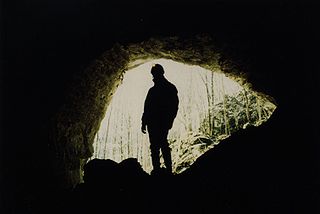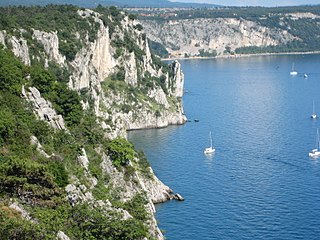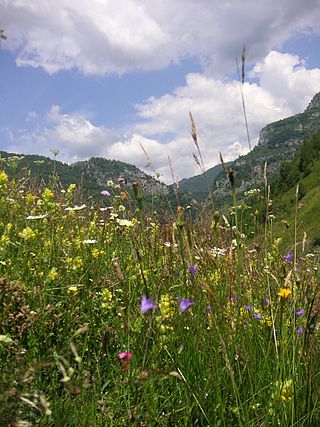
Karst is a topography formed from the dissolution of soluble carbonate rocks such as limestone, dolomite, and gypsum. It is characterized by features like poljes above and drainage systems with sinkholes and caves underground. It has also been documented for more weathering-resistant rocks, such as quartzite, given the right conditions. Subterranean drainage may limit surface water, with few to no rivers or lakes. However, in regions where the dissolved bedrock is covered or confined by one or more superimposed non-soluble rock strata, distinctive karst features may occur only at subsurface levels and can be totally missing above ground.

Speleology (from Ancient Greek σπήλαιον and λόγος is the scientific study of caves and other karst features, as well as their make-up, structure, physical properties, history, life forms, and the processes by which they form and change over time. The term speleology is also sometimes applied to the recreational activity of exploring caves, but this is more properly known as caving, potholing, or spelunking. Speleology and caving are often connected, as the physical skills required for in situ study are the same.

The Karst Plateau or the Karst region, also locally called Karst, is a karst plateau region extending across the border of southwestern Slovenia and northeastern Italy.

A show cave—also called tourist cave, public cave, and, in the United States, commercial cave—is a cave which has been made accessible to the public for guided visits.

An ice cave is any type of natural cave that contains significant amounts of perennial (year-round) ice. At least a portion of the cave must have a temperature below 0 °C (32 °F) all year round, and water must have traveled into the cave’s cold zone.

The Domica cave is a karst cave situated on the south-western border of the Silicka planina Plateau 10 km (6.2 mi) south-east of Plesivec in the Rožňava District of the Košice Region in southern Slovakia. In combination with the Baradla cave, it makes up the most significant section of the Aggtelek Karst and Slovak Karst cross-border cave network that continues into the Aggtelek National Park in Hungary. The cave is well-known for its complex structure and high density of speleothems.

Jasov Cave is a speleothem limestone cave and archaeological site in the Slovak Karst in Slovakia. It is located near the village of Jasov, around 25 km (16 mi) from Košice city. Along with a number of caves of the Slovak Karst, Jasov Cave has been induced into the UNESCO World Heritage list as a part of the Caves of Aggtelek Karst and Slovak Karst site, because of its unique diversity of speleothems and its testimony to tropical and temperate cave-forming processes. The cave is known for its pagoda-like stalagmites, sinter waterfalls, and straw stalactites.

Karst Underwater Research (KUR) is a registered 501(c)(3) non-profit organization that specializes in the research and documentation of karst aquifers and their corresponding surface features. KUR members perform a variety of scientific processes, including mapping and cartography, radio location, photography, videography, YSI water analysis and sampling.

A ponor is a natural opening where surface water enters into underground passages; they may be found in karst landscapes where the geology and the geomorphology is typically dominated by porous limestone rock. Ponors can drain stream or lake water continuously or can at times work as springs, similar to estavelles. Morphologically, ponors come in forms of large pits and caves, large fissures and caverns, networks of smaller cracks, and sedimentary, alluvial drains.

The Caves of Aggtelek Karst and Slovak Karst are a series of over 1000 karst caves spread out over a total area of 55,800 ha along the border of Hungary and Slovakia. With an exceptional diversity of karst structures and complex cave systems developing from both temperate and tropical processes, the caves and surrounding areas were inscribed as a UNESCO World Heritage Site in 1995.
A salt cave is a cave formed within rock salt by dissolution of this very soluble rock by water. As with other soluble rocks, a distinctive set of landscape features can arise from the solutional process; in this case it is known as salt karst or 'halite karst'. The three key areas of salt karst are those in Iran, Israel and Spain, together with an example in Romania. Malcham cave in Israel is the longest salt cave in the world with a measured length of over 10km. It is located at Mount Sodom. There are significant salt caves on Qeshm Island in Iran including Tri Nahacu Cave and Namakdan Cave. This cave was listed in October 2022 by the International Union of Geological Sciences in their 'First 100 IUGS Geological Heritage Sites' as being of global significance for the understanding of tectonics and ongoing geological processes. Amongst the caves developed within the several salt karsts in Spain are Cova dels Meandres de Sales which at 4.3km in length is the world's third longest. The fourth longest is Pestera 6S de la Mânzălesti, in România, at 3.1km in length.

A solutional cave, solution cave, or karst cave is a cave usually formed in the soluble rock limestone. It is the most frequently occurring type of cave. It can also form in other rocks, including chalk, dolomite, marble, salt beds, and gypsum.

Turda Gorge is a natural reserve situated 6 km west of Turda and about 15 km south-east of Cluj-Napoca, in Transylvania, Romania.

The Semenic-Caraș Gorge National Park is a protected area situated in southwest Romania, in Caraș-Severin County.

The Grădiștea Muncelului-Cioclovina Natural Park is a protected area situated in Romania, in Hunedoara County.
The Apuseni Natural Park is a protected area situated in Romania, in the administrative territory of counties Alba, Bihor and Cluj.

The Baradla Domica cave system is a large cave system in northern Hungary. As part of the Aggtelek Karst, it extends more than 25.5 km (25,500 m) and includes the 5.3 km (3.3 mi) Domica cave. A significant part of the cave has varied colors and shapes providing an unparalleled spectacle of decorative stalactites.

The Cliefden Caves is a heritage-listed geoheritage site in Mandurama, Cowra Shire, New South Wales, Australia. The caves comprise Ordovician fossil localities, limestone caves, a spring and tufa dams, and a site where limestone was first discovered in inland Australia.
Topolnița Cave is a karst cave located in Mehedinți County, Romania. It is the fourth-longest cave in Romania: only Peștera Vântului, Humpleu-Poienița Cave, and Hodobana Cave are longer. Most speleological sources estimate its length at 20.5 km (12.7 mi), although a length of 22 km (14 mi) has also been reported. Some Romanian news sources report a more conservative 11,000 metres (36,000 ft). It is considered a natural monument of Romania.















